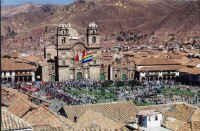|
June 22, 2000 For the past few days we've been travelling through the Sacred Valley of the Incas. We visited the town of Ollantaytambo where there are more wonderful ruins. The town itself is laid out according to the original Inca plans. The ruins sit directly above the city and the steep terraces are very impressive. We were particularly impressed with the underground water system that the Incas used to divert water from the river to their baths. They had also carved walkways and staircases directly into a rock wall. Early the next morning we visited the Inca salt pans outside of Urubamba. These salt pans are still being used today. To get there we had to take a bus, then a taxi. The taxi driver would only take us to the overlook above the pans so we had to hike the final 2 kilometers. The hike was really beautiful though as we could see the hundreds of salt pans on our way down. Once we arrived, we were able to walk along the mazes of trails through the pans. We were really lucky we arrived when we did, as when we looked up at the hillside, we could see more tourist hordes getting ready to come down. After traversing the pans, we hiked 4 kilometers (km) back to the highway and caught a collectivo (shared taxi) back to town. Next on the agenda was a visit to the town of Pisac. The ruins sit high on a mountainside and included steep terraces for farming. We also discovered mazes of rooms and looted tombs on the hillsides. After descending from the ruins, we discovered a crafts market going on in town. It was difficult to walk on the cobblestone streets, but the interesting crafts made it an adventure. Returning to Cusco, we found the city to be highly charged with energy. And people. Lots and lots of people. Inti Raymi was only 2 days away and people had arrived from all over the world to view this spectacle. On our first evening in town, there was a concert in the main plaza. We watched the concert from afar and then decided to head for our hotel. On our way up a steep staircase, we saw the first flashes of color from fireworks. We stopped to watch and were amazed by the display. After about 15 minutes we thought the show was over, but it had just begun. We stood on the steps with about 10 other people and oohed and aahed together for another 15 minutes. After the third grand finale, the show ended and we hiked off to bed. For dinner that evening we decided to have the Peruvian delicacy "cuy". Translated, that means guinea pig. It is a traditional dish that is roasted or fried and served whole. We ordered ours roasted and had to wait an hour for it to be served. During our wait we were entertained by Quechua musicians playing traditional music on flutes and stringed instruments. When our cuy arrived, it was attractively laid out on a platter with a tomato in its mouth. The waiter asked us if we wanted to take a picture but we declined. He then took it back to the kitchen and quartered it for easier eating. Oh, and he removed the head. The present holiday was resurrected by the City of Cusco in the 1970's and is celebrated as a pageant. Nearly 200 people portray Incas in various roles. The finale is the mock sacrifice of a llama. It was the greatest of all the Inca festivals. The next day we moved on, by means of a 20 hour bus and taxi ride across the Andes to the city of Ayacucho. The ride was over very rough, narrow "roads", through great vistas. The roads themselves were exciting as they had no guard rails and were not even wide enough to pass other vehicles. We traveled up to the Altiplano at nearly 12,000 feet, then dropped down into valleys that were only hundreds of feet above sea level, then climbed back up. Up and down, that was how the day went until we finally arrived, thankfully in one piece.
|
|
